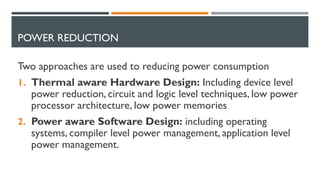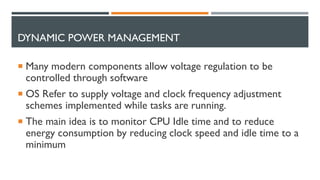Parallel and Distributed Computing Chapter 9
- 1. PARALLEL AND DISTRIBUTED COMPUTING POWER AND ENERGY CONSUMPTION
- 2. HPC (HIGH PERFORMANCE COMPUTING) HPC is parallel processing for running advance applications(that are either too large or would take too long for standard computers). HPC is network of nodes each of which contain one or more processing units as well as it own memory.
- 3. INTRODUCTION Energy efficient computing isn’t limited to main computing only i.e. processors, storage devices etc. But it can expand to much larger range of resources e.g. auxiliary equipment, cooling system even space etc.
- 4. ENERGY CONSUMPTION Computers have developed to achieve higher performance June 2010:Three super computers achieved petaflops (1015)/Sec While performance has increased, power consumption also increased Such increased energy consumption causes sever economic, ecological and technical problems
- 5. ENERGY CONSUMPTION – PROBLEMS Economical Impact: computer systems consume tremendous amount of energy. It has been reported that desktop computers in US consumer over 10% of electricity. Large data center such GOOGLE consume as much electricity as small town. Moreover cooling bill for heat dissipation can be as high as 70% of above cost. Super computers often need to construction of even entirely new buildings.
- 6. ENERGY CONSUMPTION – PROBLEMS Ecological Impact: desktop computers produce as much carbon dioxide as millions of cars entirely. Heat dissipation problem gets increasingly worse because of higher computing speeds As per report Information technology industry generates as much greenhouse gas as the international airline.
- 7. ENERGY CONSUMPTION – PROBLEMS Technical Impact: large scale multiprocessors requires expensive packaging and cooling technologies and demand highly fault tolerant mechanism due to heat dissipation caused by increased energy consumption
- 8. POWER REDUCTION In addition to measure Performance using FLOPS , Green500 uses FLOPS/Watt to ran the performance of computing system All current systems that can achieve at least 400MFLOPS/W are considered as high performance/power
- 9. POWER REDUCTION Two approaches are used to reducing power consumption 1. Thermal aware Hardware Design: Including device level power reduction, circuit and logic level techniques, low power processor architecture, low power memories 2. Power aware Software Design: including operating systems, compiler level power management, application level power management.
- 10. DYNAMIC POWER MANAGEMENT Many modern components allow voltage regulation to be controlled through software OS Refer to supply voltage and clock frequency adjustment schemes implemented while tasks are running. The main idea is to monitor CPU Idle time and to reduce energy consumption by reducing clock speed and idle time to a minimum
- 11. DYNAMICVOLTAGE AND FREQUENCY SCALING (DVFS) The most commonly used technique for CPU Power management is dynamic voltage and frequency scaling DVFS: which is a technique to reduce power dissipation by lowering processor clock speed and supply voltage.
- 12. POWER ALLOCATION PROBLEMS Power allocation and task scheduling problems contain four non trivial sub problems 1. System Partitioning: Since each parallel task request for multi processor, so multiprocessor should be partitioned into clusters of processors to be assigned to tasks. 2. Precedence constraining: make design and analysis of heuristic algorithms more difficult.
- 13. POWER ALLOCATION PROBLEMS 1. Task Scheduling: precedence constrained parallel tasks are scheduled together with system partitioning and precedence constraining. 2. Power Supplying: tasks should be applied with appropriate powers and execution speeds
- 14. TYPES OF ALGORITHM Three types of power-aware task scheduling algorithms 1. Pre-Power Determination Algorithm: first determine power supplies and then schedule the tasks. 2. Post-Power Determination Algorithm: first schedule the tasks and then determine the power supplies 3. Hybrid Algorithms: scheduling tasks and determining power supplies are interleaved among different stages of an algorithm
- 15. POST -POWER DETERMINATION ALGORITHM List Scheduling (LS): Schedule a list of tasks 1,2,…n. Task k is scheduled on processor k where 1≤ k ≤ m. tasks are removed from the list.This process repeats until all tasks are finished Variation of LS: Largest Requirement First (LRF): same as LS except that the tasks are arranged such that r1 ≥ r2 ≥ … ≥ rn Smallest Requirement First (LRF): same as LS except that the tasks are arranged such that r1 ≤ r2 ≤ … ≤ rn
- 16. PRE-POWER DETERMINATION ALGORITHM First determine the power supplies and then schedule the tasks. We consider three pre-power determination algorithms: 1. Equal time Algorithm: power supplies p1,p2…pn are determined in such that all tasks have identical execution time i.e. t1 = t2 = … =tn 2. Equal Energy Algorithm: power supplies p1,p2…pn are determined in such that all tasks consume same amount of energy i.e. e1 = e2 = … =en 3. Equal Speed Algorithm: power supplies p1,p2…pn are determined in such that all tasks executed at same speed i.e. s1 = s2 = … =sn
- 17. ENERGY EFFICIENCY IN HPC SYSTEM Data shows that every 10◦C increase in temperature results in doubling of system failure rate Which reduces reliability of these expensive systems
- 18. TECHNIQUES – POWER MANAGEMENT AND ENERGY EFFICIENCY 1. CPU Power management 2. Component-Based Power Management 3. Power management in virtualized datacenters
- 19. TECHNIQUES – POWER MANAGEMENT AND ENERGY EFFICIENCY CPU Power management 1. OS-Level CPU Power management: Controlling the sleep states / C-State and P-State of processor when processor is idle. C-State is capability of processor to be in various low power idle states with varying wakeup latency. P-state is capability of running processor at different voltage and frequency level. Modern Oss implement ACPI(Advance configuration and power interface) based policies to reduce the processor performance and power when it is less active or in idle state.
- 20. TECHNIQUES – POWER MANAGEMENT AND ENERGY EFFICIENCY CPU Power management 2. Workload-level CPU Power management: Different scheduling algorithms and mechanisms to save energy to provide power management. 3. Cluster-level CPU Power management: management agent running on each server and the server that exceeded the power budget according to the SLA (Service Level Agreement) is throttled down to an appropriate level
- 21. TECHNIQUES – POWER MANAGEMENT AND ENERGY EFFICIENCY 1. CPU Power management 2. Component-Based Power Management 3. Power management in virtualized datacenters
- 22. TECHNIQUES – POWER MANAGEMENT AND ENERGY EFFICIENCY Component-Based Power Management: Although CPU is the component that requires most power relative to other components. However power required by each component depend upon workload
- 23. TECHNIQUES – POWER MANAGEMENT AND ENERGY EFFICIENCY 1. CPU Power management 2. Component-Based Power Management 3. Power management in virtualized datacenters
- 24. TECHNIQUES – POWER MANAGEMENT AND ENERGY EFFICIENCY Power management inVirtualized Datacenters: With increase of cloud computing, virtual datacenters are being increased. VMM (Virtual Machine Monitor) to control the coordination amongVMs to reduce power consumption























